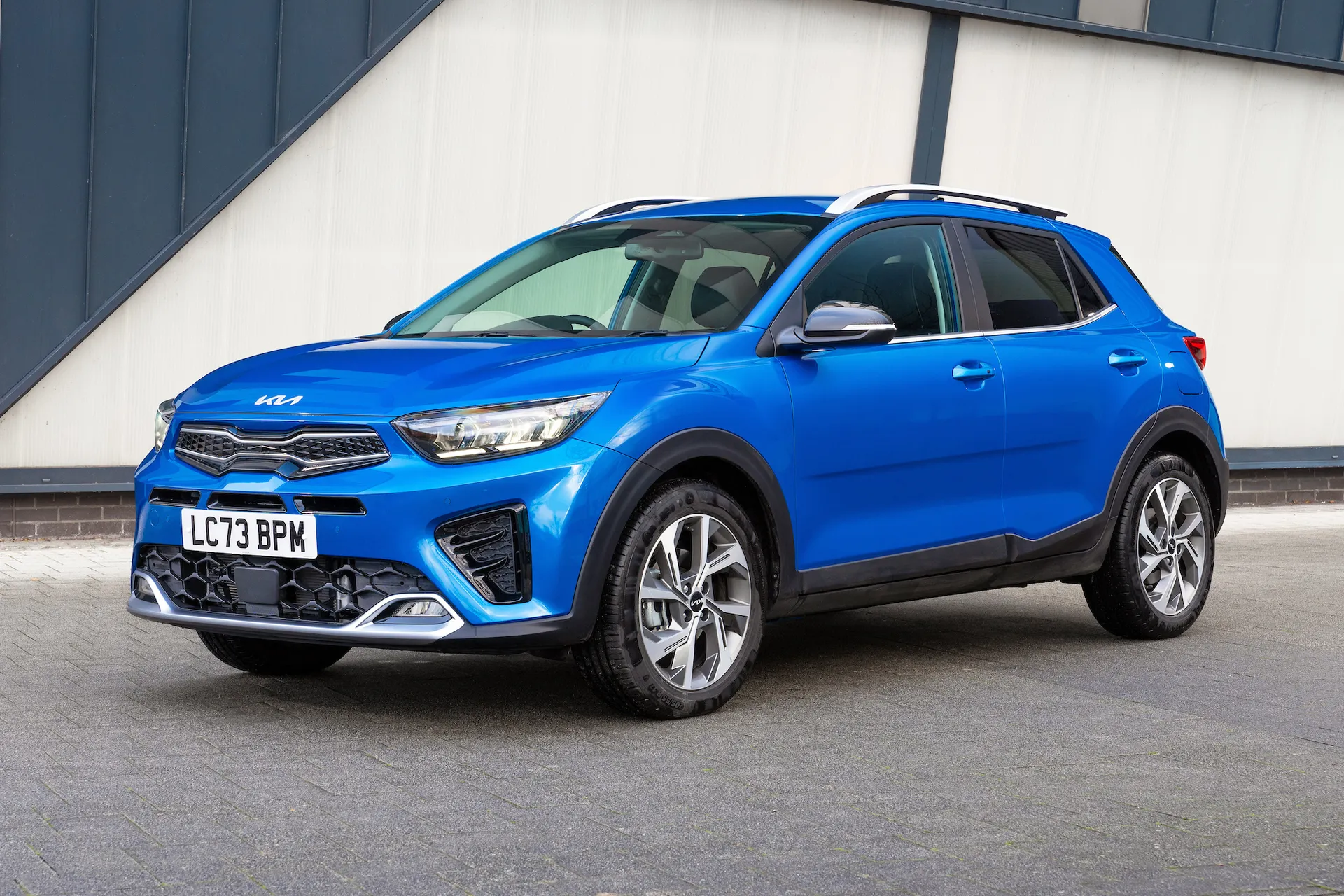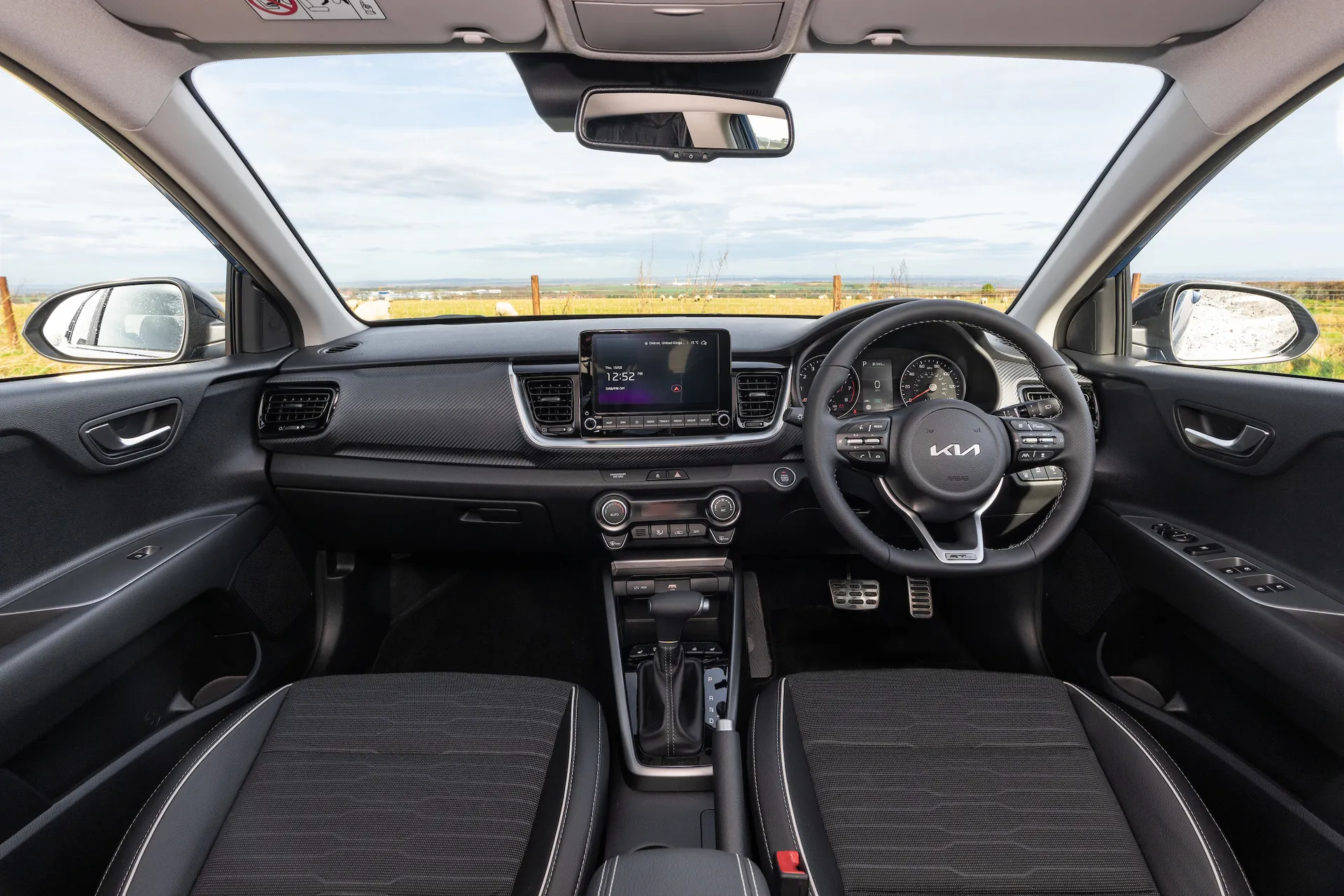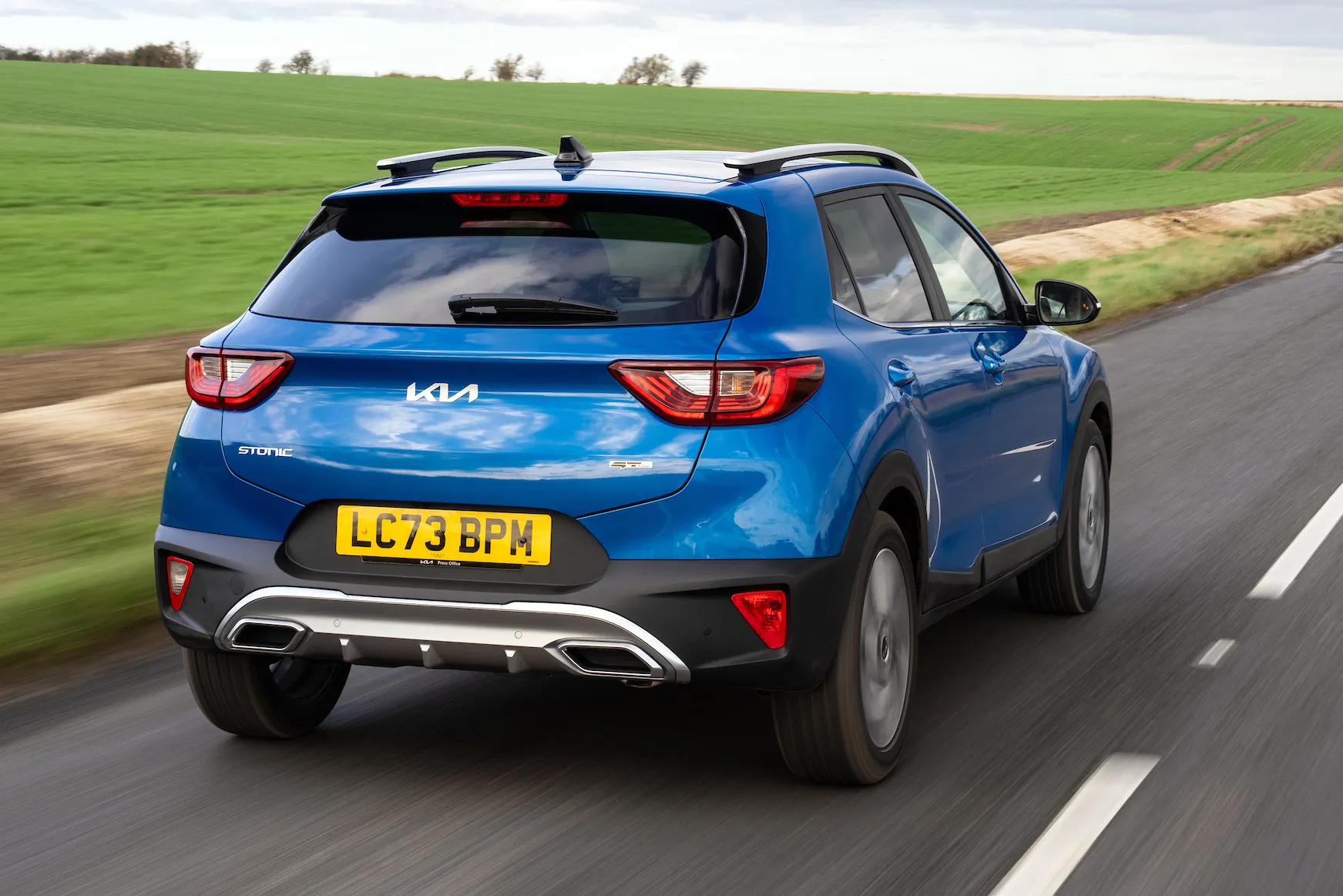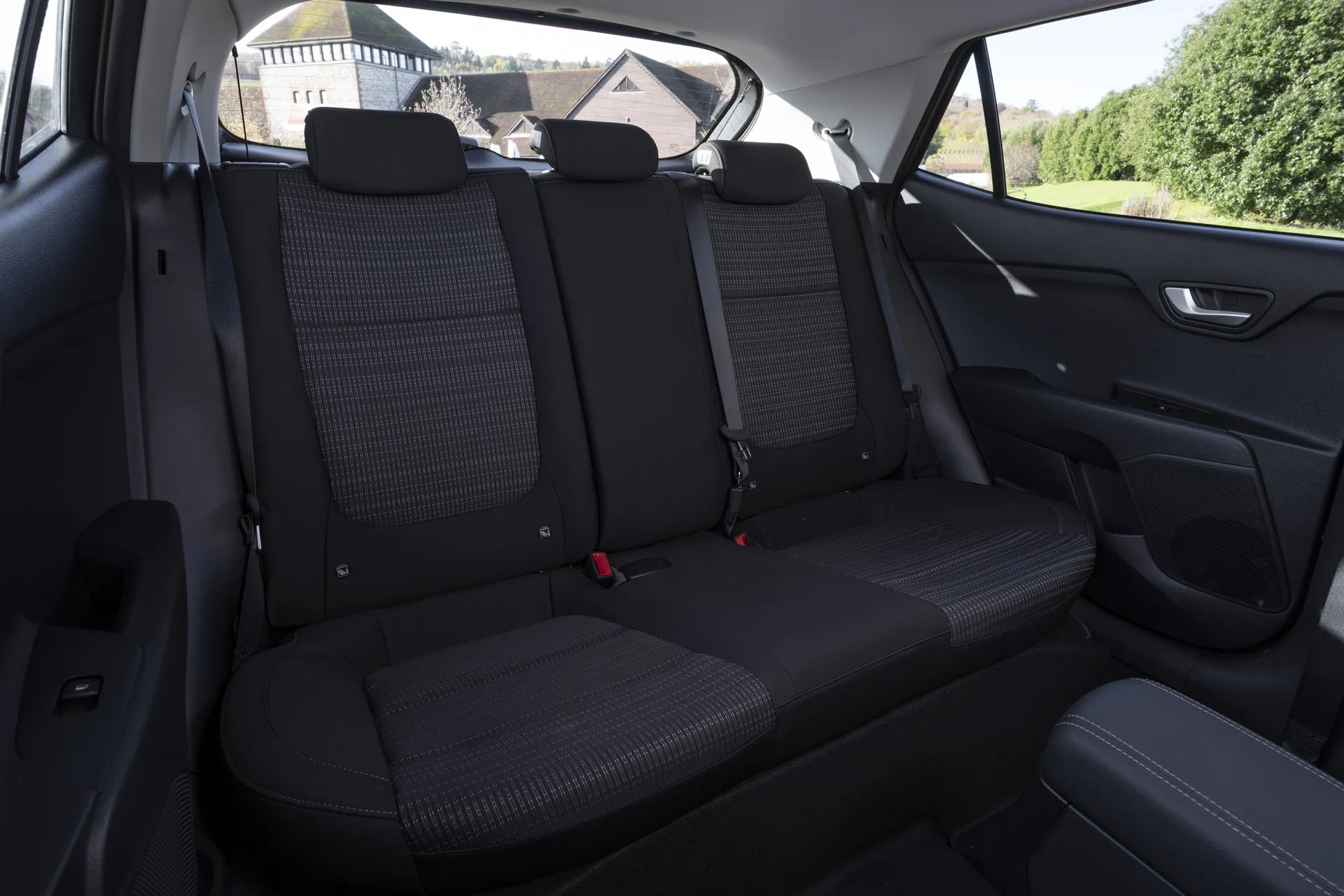Kia Stonic Review 2025: Price, specs & boot space
Written by Andrew Brady
Quick overview
Pros
- Even the entry-level version has plenty of kit
- The 1.0-litre turbocharged engine is punchy and efficient
- A class-leading seven-year warranty
Cons
- It doesn’t feel like a small SUV
- Limited space for rear-seat passengers
- Lacks the high driving position of its rivals
Verdict: Is the Kia Stonic a good car?
"In isolation, the Kia Stonic is a thoroughly decent car. It’s cheap to run, well-equipped and backed by an industry-leading warranty. It loses marks for the limited space in the back, a harsh ride and a curiously low-slung driving position. We’d be tempted to reduce its mark for the portmanteau name. ‘Speedy’ and ‘tonic’ – hmm..."

The Kia Stonic isn’t a bad car. Far from it. It comes loaded with standard equipment, looks pretty good and is backed by one of the industry’s best warranty packages. Unless you already own one, you may also have forgotten it exists – and may be surprised to hear that Kia still offers the Stonic brand new in its ever evolving and ever more stylish range.
Very few sectors of the car market are as crowded as the small SUV sector right now, and that means the Kia Stonic has a great many rivals to fend off. In summary, the Stonic simply isn’t comfortable enough or refined enough to match the class leaders, most notably the SEAT Arona, Renault Captur and Nissan Juke. But that’s not to say that the Kia Stonic shouldn’t be on your shortlist if you’re after a small SUV.
It’s based on the now-defunct Kia Rio, but the Stonic is taller and wider than the supermini, with extra length behind the back wheels to create more luggage space. As a result, it’s more practical than the Rio, but not to the extent you might think.
The boot space in the Kia Stonic is a decent size, but because the rear seats don’t slide forwards and backwards, it lacks the flexibility of some other small SUVs. Space is also limited in the back seats, so some adults might struggle to find enough headroom and legroom.
Things are better up front, with the Kia Stonic offering a generous amount of shoulder room and headroom. There’s a large glovebox, a pair of cupholders, two large door bins and a centre storage box with armrest.
The cabin looks a little plain, but the dashboard has a logical layout with all the buttons and switches sitting where you expect to find them. Perceived quality is helped by the leather-trimmed steering wheel and gear knob, but some of the materials used throughout the cabin feel cheap and plasticky, and the assembly feels a little flimsy and insubstantial in places.
At least the Stonic is well-equipped, with all versions featuring alloy wheels of 16 inches or more, an eight-inch touchscreen, DAB digital radio, Apple CarPlay, air conditioning, rear parking sensors and cruise control.
Other trim levels offer more kit and cosmetic upgrades, with the flagship Stonic boasting heated front seats, a heated steering wheel, satellite navigation and leather upholstery. Top trim models also feature the safety kit required for the maximum five-star Euro NCAP safety rating, but models without the pack are given a three-star rating.
The Kia Stonic's driving experience is a little odd. While most small SUVs offer a lofty driving position, you sit low in the Stonic, which makes it feel like a humble supermini. It also prioritises handling over ride comfort, but never feels especially exciting to drive. It’s kind of lost between a rock and a hard place.
In isolation, the Kia Stonic is a perfectly adequate car. It looks good, comes loaded with plenty of equipment, and is backed by a seven-year warranty. It just fails to impress, leaving you feeling like you’re driving a slightly larger and chunkier Kia Rio.
Our money would go on the SEAT Arona, which is one of the best all-rounders in a seriously crowded market.
Looking for a used car for sale? We've got 100s of Kia Approved Used Cars for Sale for you to choose from, including a wide range of Kia Stonic cars for sale.
Is the Kia Stonic right for you?
Wander into the showroom of any mainstream car manufacturer and you’ll be greeted with a small SUV of some description. So what makes the Kia Stonic different to any of its many rivals?
In truth, not a lot. It follows the same basic formula as the rest, offering a touch more practicality than the supermini upon which it is based, along with some chunky and fashionable SUV styling.
Beyond that, it comes down to brand loyalty, price and peace of mind. The Stonic is backed by Kia’s excellent seven-year warranty and you do get a lot of toys for your money. However, when viewed in the context of its rivals, it feels the least like a small SUV. This may or may not be a good thing, depending on your point of view.
In isolation, it’s a thoroughly good small car. But there are more authentic small SUVs available.
What other cars are similar to the Kia Stonic?
How long have you got? Every mainstream manufacturer offers a small SUV of some description, but the Stonic’s chief rivals include the Hyundai Kona, Renault Captur, SEAT Arona, Suzuki Vitara, Nissan Juke, Peugeot 2008 and Citroen C3 Aircross. Oh, and the Ford Puma, Alfa Romeo Junior Hybrid Hybrid, DS3, Skoda Kamiq, Jeep Avenger Hybrid, Toyota Yaris Cross, and the Dacia Duster. And probably a few we’ve forgotten. Basically, if you can’t find a car you want from that little lot, you probably don’t want a small SUV to begin with.
The Stonic also faces an enemy from within. The Kia XCeed is more expensive, but it looks and feels more special than the Stonic.
Comfort and design: Kia Stonic interior
"The Kia Stonic is a bit of an oddball, because the low-slung driving position is more akin to a supermini than to a small SUV. If you’re after a lofty stance, look elsewhere."

The Kia Stonic's interior is also lacking in flair and imagination, with few of the design flourishes you might find in competitors. The perforated, leather-trimmed steering wheel on the Stonic 3 trim level is a nice touch, mind.
Beyond that, the Stonic looks and feels very much like a Kia Rio supermini. This isn’t necessarily a bad thing, because Kia knows how to deliver a clear and logical dashboard. Everything is in the right place – it just looks a little drab.
Getting comfortable shouldn’t be a problem, as all versions come with a height-adjustable driver’s seat and a steering wheel that’s adjustable for height and reach. Forward visibility is good, but the rear view is restricted by the wide rear pillars. Fortunately, all models come with parking sensors as standard, while a reversing camera is fitted to all except the Stonic 2.
A centre storage box doubles up as an armrest in all models, which, when combined with the standard-fit cruise control, makes the Stonic a comfortable companion on a long trip.
Quality and finish
First impressions are excellent. Kia has a knack of making its interiors look more upmarket than prices would suggest, and at first glance, you initially think that the Korean company has done it again.
Unfortunately, look a little closer and things start to unravel. The plastic used on the dashboard, door panels and centre console feel cheap and scratchy. The cost-cutting is especially noticeable in the entry-level Stonic, with the fabric seats feeling a little low-rent, while the silver-finished door handles are a tad flimsy.
Kia has trimmed the steering wheel and gearstick in leather, which helps to raise the level of perceived quality a little. Some versions get a flat-bottomed steering wheel and cloth and faux-leather trimmed seats, for a sporty feel.
The Stonic 3 also gets a black high-gloss centre console, faux leather upholstery, automatic climate control and an auto-dimming rear-view mirror. In earlier models you needed a Stonic 4 to get heated front seats, a heated steering wheel, keyless start, faux leather and aluminium pedals, but several of these features are now available further down the range; you can read a more in-depth specification list further down.
Although the Kia XCeed is larger and more expensive, it feels more premium on the inside. The Stonic is by no means poor, it just lacks sparkle.
Infotainment: touchscreen, USB, nav and stereo in the Kia Stonic
All versions of the Kia Stonic get an eight-inch touchscreen infotainment system with DAB digital radio, Apple CarPlay, Android Auto, Bluetooth and voice control. There’s also a USB port for the front seats, another one for the back, six speakers and audio controls on the steering wheel.
It’s easy to use, helped in no small part by the large and prominent buttons and dials flanking the screen. The display is crisp and clear, although it can be a little slow to respond to inputs.
Current models also get satellite navigation as standard, plus traffic messaging and a range of connected services for a full seven years, though how much you’ll use them when Apple CarPlay and Android Auto are standard anyway, we’re not sure. The Kia’s built-in navigation has a habit of sending drivers on some obscure routes, especially when avoiding traffic delays.
On the plus side, the sound quality is excellent for a standard audio system, aided by a pair of tweeters mounted in the doors. We also applaud Kia’s decision to put a USB port in the back, because the passengers seated there could use some cheering up due to their drab surroundings.
Space and practicality: Kia Stonic boot space
While the Kia Stonic and Rio hatchback share the same wheelbase (that's the space between the front and rear wheels), the overall dimensions of the Stonic are slightly bigger. The Stonic is 4140mm long, 1760mm wide and 1520mm high. Crucially, the rear overhang has been extended by 70mm (compared to the Kia Rio), which gives the Stonic a larger boot.
With the rear seats in place, the Kia Stonic's boot offers 352 litres of space, which is 27 litres more than you get in the Rio. It’s not the largest in the small SUV segment - for example, the Renault Captur offers up to 536 litres thanks to a sliding rear seat, which is something you don’t get in the Stonic - but the Stonic’s boot benefits from a wide and tall opening.
There’s a relatively high loading lip, but the Stonic scores well for its 60/40 split-folding rear seats, which fold flat to deliver up to 1155 litres of luggage capacity. Again, this is good, but not great. You also need to buy the Stonic 4 to benefit from a dual-height boot floor and a luggage net, which seems a bit mean.
While there’s plenty of shoulder room and headroom in the front, things are a little tighter in the back. Adults will struggle for legroom if there are tall people in the front, while headroom is restricted for all but the shortest of adults. You’d expect more from a small SUV.
Space for oddments is also at a premium in the back, with Kia offering just one seatback pocket and a pair of small door bins. What’s more, you wouldn’t want to sit in the middle seat for any length of time because it's a little uncomfortable. There are two ISOFIX points for child car seats, though.
Storage is a little better in the front, with the Kia Stonic packing a pair of large door pockets, a big glovebox and a spacious central storage bin. There’s also ample space for a smartphone in the centre console.
There are two cupholders in the front, a light in the glovebox, luggage net hooks in the boot, a case for sunglasses above the windscreen, plus a 12v socket in the centre console.
Handling and ride quality: What is the Kia Stonic like to drive?
"The Stonic’s low-slung driving position is matched by ride and handling characteristics that are more akin to a supermini than a small SUV. This gives it an almost unique feel in a sector dominated by lofty cars with raised seats."

The suspension is tuned more for handling than for ride comfort. All versions come with 17-inch alloy wheels, which have a tendency to crash into potholes, sending vibrations into the cabin. The Stonic can also feel unsettled over rough and rutted surfaces.
There are some positives. There’s very little body roll when cornering, while the low driving position does make you feel like you’re in control. Despite the keen handling, though, the Kia Stonic never feels all that much fun to drive, especially if you opt for the diesel engine. You can see what Kia was trying to achieve, but the Stonic fails to deliver.
We spent some quality time with a Seat Arona, alongside the Kia Stonic. The difference between the two cars is like night and day, with the Arona managing to feel comfortable and relaxing on a long trip, but surprisingly agile and nimble when cornering.
Having said all that, the Stonic is easy to drive in the city, where the light steering and good forward visibility rise to the fore. The view out of the back is a little restricted, which is where the reversing camera of some of the higher-spec Stonics comes in handy.
We also like the way the Stonic offers a straightforward approach to driving. GT-Line models get driving modes but they don’t really affect the car’s fundamental feel, so what you see is broadly what you get. Kia doesn’t offer a four-wheel-drive version, because it says demand is too low.
What engines and gearboxes are available in the Kia Stonic?
Although a 99PS 1.4-litre MPI petrol engine was available at launch, it has since been deleted from the Stonic range, being replaced by the 99PS 1.0-litre T-GDi unit, a turbocharged three-cylinder petrol engine that has a slightly more eager power delivery, and a 48-volt mild hybrid model that makes identical power, has identical performance, and is… marginally less economical, for some reason.
For a time the 1.0-litre T-GDi unit was also available with 120PS, and that's the sweet spot of the range if you’re shopping for a used version. It's enough to propel the Stonic to 62mph in a respectable 9.9 seconds, before hitting a top speed of 114mph. It’s also pretty frugal, offering up to 47.1mpg on a combined cycle. The economy and the 0-62mph time suffer if you opt for the seven-speed automatic transmission, though. The lower-power T-GDi gets from 0-62mph in 11.3 seconds with the manual gearbox and 12.4 seconds with the dual-clutch (DCT) automatic.
A 115PS 1.6-litre CRDi engine is offered, but we find it hard to recommend unless you spend a lot of time on the motorway. It’s a characterless engine that will pull the car from a standstill to 62mph in 10.5 seconds before reaching a top speed of 112mph. It also offers 56.5mpg in official tests.
In all cases, the engine sounds coarse and noisy when you’re accelerating hard, while the diesel is also too audible at idle and motorway speeds. Aside from the improved economy on a long run, we don’t see why you’d choose the 1.6-litre diesel over the peppy 1.0-litre petrol.
As for the transmissions, the six-speed manual gearbox is satisfying enough, but the smooth and relaxed dual-clutch automatic would be our choice. Unfortunately, it’s not available on the entry-level Stonic.
Refinement and noise levels
The Kia Stonic lacks refinement, which is especially noticeable if you’ve experienced the bigger XCeed. There’s plenty of wind and road noise at motorway speeds, while the firm suspension gives the Stonic an unsettled and fidgety feel.
We’d avoid the 1.6-litre CRDi diesel, which delivers plenty of clatter when idling and a significant amount of noise under load and when cruising. There’s also a curious metallic sound when you lift off the accelerator, too.
Things are no better in the petrol versions of the Stonic. The 1.4-litre MPI four-cylinder engine offered earlier on felt dated even when new and has to be pushed hard to make real progress.
The modern 1.0-litre turbocharged engine is a better unit, but some people won’t like the thrum of the three-cylinder unit. We’d argue that it injects the Stonic with some much-needed character, but maybe we’re being too generous. Overall, the Stonic lacks the comfort, refinement and quality we’d expect from a mid-range small SUV. The Seat Arona is proof that a small SUV can be good at everything.
Safety equipment: How safe is the Kia Stonic?
The Kia Stonic has been awarded two safety ratings by Euro NCAP. One is for high-spec versions with the full suite of driver assistance systems, the other is for lower-end versions without the safety kit (however, both ratings have now expired as the tests took place in 2017 and Euro NCAP says ratings only apply for a five year period due to ever-increasing safety standards).
With everything fitted, the Stonic got a maximum five-star rating, with scores of 93% for adult occupant protection, 84% for child occupant protection, 71% for pedestrian safety, and 59% for safety assist technology.
Without the safety pack, however, these scores drop to 85% for adult occupant protection, 84% for child occupant protection, 62% for pedestrian safety, and 25% for safety assist technology. Crucially, it earned just a three-star safety rating.
For a five-star car, you need to order the Stonic 3 or 4, or add forward collision-avoidance assist and lane keeping assist to the Stonic 2. The safety kit isn’t available on the Stonic Maxx.
Standard safety equipment includes twin front airbags, twin side airbags, twin curtain airbags, two ISOFIX points, electronic stability control, hill-start assist control, tyre pressure monitoring and emergency stop signalling. Blind-spot detection with rear cross-traffic alert is only available on the Stonic 4.
All versions come with rear parking sensors and an external temperature display, but the entry-level Stonic misses out on a reversing camera.
MPG and fuel costs: What does a Kia Stonic cost to run?
The Stonic’s fuel economy figures are competitive when compared with those of supermini-sized SUV rivals, but they're not class-leading.

Predictably, the 1.6 CRDi diesel engine offers the best economy figure, with the potential to offer 56.5mpg. It’s no longer offered new however, and unless you spend most of your time on the motorway, we’d recommend the petrol engine.
The 1.0 T-GDi can deliver up to 51.4mpg with the entry-level 16-inch wheels and a manual gearbox, or 50.4mpg with the dual-clutch automatic. 17-inch wheels drop these numbers to 48.7mpg and 47.1mpg combined.
Mild hybrid models don’t show any real economy benefit, which does make you wonder why it exists. A manual car on 17-inch wheels does 50.4mpg and 49.6mpg with the DC.
Kia Stonic reliability and warranty
Kia's transferable seven-year, 100,000-mile warranty has helped the brand build a good reputation for customer satisfaction, which is reflected in the fact that it came 8th overall in the manufacturer rankings of HonestJohn.co.uk's latest Satisfaction Index. And it seems that the company's confidence in the reliability of its products are well founded, because the brand ranked seventh overall in the reliability standings of the same study, although the Stonic wasn't namechecked specifically.
There aren't a great deal of issues to look out for with the Stonic, though. We've heard of the petrol particulate filter warning light illuminating, but that's rare. Small, turbocharged engines like the Stonic's 1.0 T-GDi don't have the best form for long-term reliability but, so far, owners seem fairly content.
Kia Stonic insurance groups and costs
The Kia Stonic is a cheap car to insure, with insurance groups ranging from 8 to 10 for brand new models, and up to 14 for some older versions. Cars with the dual-clutch automatic transmission are a little cheaper to insure than those with the manual gearbox.
Insurance groupings on the Seat Arona are slightly higher than those of the Stonic, with the small Spanish SUV slotting into groups 11 to 18.
VED car tax: What is the annual road tax on a Kia Stonic?
Because the Stonic was released (just) after the tax rules changed in April 2017, you pay the same flat rate of £195 per year on all versions, following April 2025’s rate increases. No version costs more than £40,000 even when every available optional extra is fitted, so buyers won't be liable for the ‘luxury car’ surcharge.
The Stonic probably won’t be such a popular company car, and not just because company users can surely find more interesting models on their shortlist. It’s more that CO2 emissions of 125g/km, while not massively polluting, still put the Stonic in the 31% tax band. A bill of around £1,500 per year for even a basic rate payer isn’t hugely appealing.
Kia Stonic price
Buy a Stonic brand new, and the range starts at just under £21,500 for a Stonic ‘2’. That doesn’t sound bad in the modern market where regular superminis seem to nudge £30k in some trim levels.

GT-Line is around £1,000 more, ‘3’ models are just shy of £24,000, and the GT-Line S is a round of drinks over £25,000. There are some big savings to be had on the used car market, however.
As the earliest models hail from around 2018 they’re now slipping out of Kia’s long factory warranty, which might dissuade some buyers, but if it doesn’t then prices of around £8,000 look fairly tempting, for both 1.6 CRDi and 1.0 T-GDi versions with around 70,000 miles, sometimes more. Spending another grand brings down the mileage to 50k-60k.
Move up to cars around three years old, still with the bulk of their warranty remaining, and £11k-£12k is a realistic starting point, so a ten grand saving over the cheapest new models. All Stonics are petrol by this point, with most in ‘2’ trim and a few GT-Line models spread around, with most hovering around 40,000 miles. Bank on around £17,000 for a year-old Stonic with under 10,000 miles.
Trim levels and standard equipment
It’s fair to say the Kia Stonic’s trim level grades aren’t especially logical. The range starts with the ‘2’, which is followed by GT-Line, then ‘3’, then GT-Line S. Presumably ‘1’ is held back for countries that place less value on high equipment levels, because ‘2’ is pretty reasonably specified for an entry-level car, with 16-inch alloy wheels, an 8-inch touchscreen with navigation and seven years of Kia online services, Apple CarPlay and Android Auto, air conditioning, rear parking sensors, LED daytime running lights, and cruise control with a speed limiter.
GT-Line upgrades to 17-inch alloys, electric folding door mirrors in contrasting black caps (well, contrasting if you don’t specify black exterior paint too), rear privacy glass, cloth and faux leather trim, LED headlights and fog lights, alloy pedals, a reversing camera, and automatic air conditioning.
‘3’ also gets 17-inch alloys but adds heated front seats and a heated steering wheel, keyless entry with a start/stop button, faux leather upholstery, an auto-dimming rear-view mirror, auto wipers, and selectable drive modes.
GT-Line S builds on GT-Line with intelligent speed limit assist, heated seats and steering wheel, smart cruise control on DCT automatic models, keyless go with a start/stop button, front and rear parking sensors, blind spot and collision avoidance assist, and cloth and artificial leather trim.
Ask the heycar experts: common questions
Where is the Kia Stonic made?
Is the Kia Stonic a good car?
What insurance group is the Kia Stonic?
Get our latest advice, news and offers
Keep me updated by email with the latest advice, news and offers from heycar.
By submitting you agree to our privacy policy




